Evolution for Everyone
Originally Published April 3, 2019
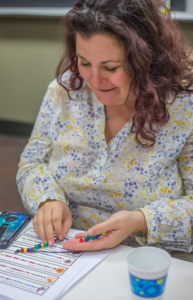
(Tara Treiber makes a DNA sequencing bracelet. Photo credit: Roee Fung)
Sabotage and subterfuge were in abundance as adult educators raced to scoop up the most toothpicks using only soup spoons. The price was high as extinction was on the line. Across the room teachers cautiously reached inside unlabelled paper bags like a yankee swap to try to piece together a Mendelian puzzle. Outside yet another group of instructors paired off and split up in an intricate line dance to visualize DNA replication. A strange basket of activities for a gathering of adults in a science library on a Saturday morning, but it all makes sense in the context of evolution.
The USC Young Scientists Program received funding allocated from a National Science Foundation (NSF) grant to promote a teacher’s evolutionary curriculum development workshop on February 10th, 2018. The workshop covered inquiry based, hands-on and NGSS aligned evolution lesson plans and resources for K-12 classrooms. The program was presented for use as a teacher resource to integrate evolution into the classroom in a variety of formats with flexible lesson plans to tailor to specific classroom needs. In all, twenty teachers attended representing 16 zip codes across central and southern California.
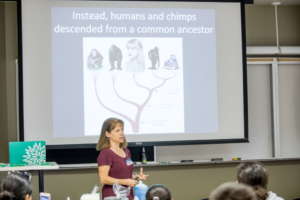 (Dr. Suzanne Edmands speaks about misconceptions of evolutionary theory. Photo credit by Roee Fung)
(Dr. Suzanne Edmands speaks about misconceptions of evolutionary theory. Photo credit by Roee Fung)
The event began with a welcome from evolutionary scientist Dr. Suzanne Edmands, a professor of Biological Sciences at USC and receiver of the NSF grant, who lay the backdrop for the paucity of evolutionary instruction in US classrooms and common misconceptions about evolutionary theory. She then transitioned into the specifics of her current research on the copepod Tigriopus californicus (type of zooplankton) and the evolution of the “Mother’s Curse.” Her project addresses the hypothesis that male-harming mutations can accumulate in the mitochondrial genome because mitochondrial DNA is only inherited from the mother, removing mitochondrial selective pressure in males.Thus, male-harming mutations are predicted to accumulate in the mitochondrial genome and result in reduced fitness of males, hence “the Mother’s Curse”. She dazzled crowds by not only elucidating the many benefits to using copepods as study specimens, but also when she brought out samples of her actual work subjects in as a visual aid.
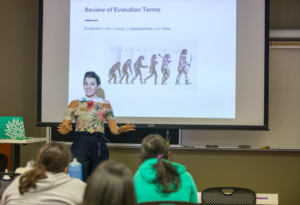 (Cecily Pulver provides an overview of evolutionary terms to attendees. Photo credit by Roee Fung)
(Cecily Pulver provides an overview of evolutionary terms to attendees. Photo credit by Roee Fung)
Attending teachers were then debriefed on general evolutionary terminology to create a common foundation for the lessons showcased at the workshop and released into focus groups by grade level. In sum, 20 evolutionary lessons were developed for teacher use, but only 3-4 from each age group were demonstrated.
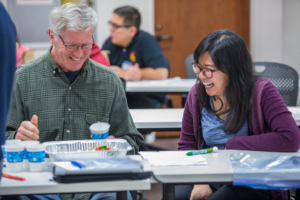 (Stephanie Ho and Eric Cleveland attempt to eat the most gummy worms using chopsticks in the adaptive radiation activity. Photo credit by Roee Fung)
(Stephanie Ho and Eric Cleveland attempt to eat the most gummy worms using chopsticks in the adaptive radiation activity. Photo credit by Roee Fung)
Kindergarten through 5th-grade teachers were presented with interactive lessons on natural selection in prey, adaptive radiation of bird beaks, and homologous bones in mammals.
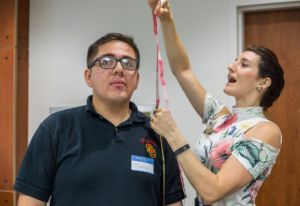 (Cecily and Manny demonstrate collecting data on variation within one classroom. Photo credit by Roee Fung)
(Cecily and Manny demonstrate collecting data on variation within one classroom. Photo credit by Roee Fung)
Middle schools teachers were introduced to 3D printed copepods for a cladogram lesson, chromosomal mutations represented with pipe cleaners, Punnett squares in paper bags for Mendelian genetics, and variation within populations modeled by student measurements and data representation.
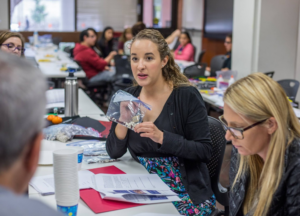 (Katie Beachem demonstrates population genetics with beans. Photo credit by Roee Fung)
(Katie Beachem demonstrates population genetics with beans. Photo credit by Roee Fung)
High school teachers explored DNA replication through a line dancing activity, DNA structure with base pair bracelets, DNA extraction with strawberries, and population genetics with a randomized bean shaking exercise. After teachers worked through sample lessons for their student age group, attendees came together to celebrate Charles Darwin’s 209th birthday with cake and group photos. In recognition of attending, all participants received a complimentary USB flash drive with 150 pages of evolutionary curriculum development materials and a 3D printed evolution keychain.
When prompted to share what they learned from the workshop, one teacher noted, “I learned there is good evolutionary science education out there. I need to maximize efforts to get it into classrooms!” In response to the particular lesson themselves, another educator commented, “Many modification and extension lessons can be built through [these lessons], even student modification in older classes.” Several instructors appreciated the hands-on approach to learning presented through the workshop, finding it so engaging they “never look at the clock once” in the 3 hour allotment. Overall, impact from represented teachers brings outreach of produced evolutionary curriculum to 2725 students. Hopefully the lesson plans and resources provided to teachers from the event will enable them to implement scaffolding to promote engaging evolutionary lessons across California.
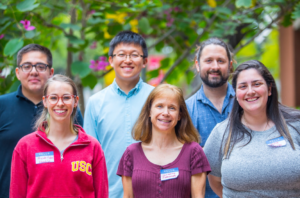
(Dr. Edmands (front center) and members of her research lab at USC. Photo credit by Roee Fung)/
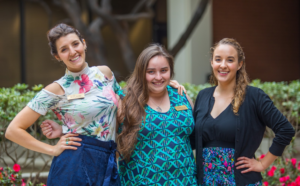
(From left to right: Cecily Pulver, Dieuwertje Kast, and Katie Beachem. Photo credit by Roee Fung)
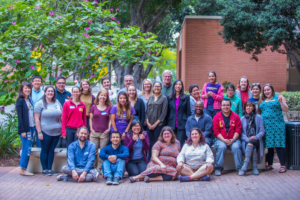
(Photo of all workshop coordinators, researchers, and educator attendees. Photo credit by Roee Fung)